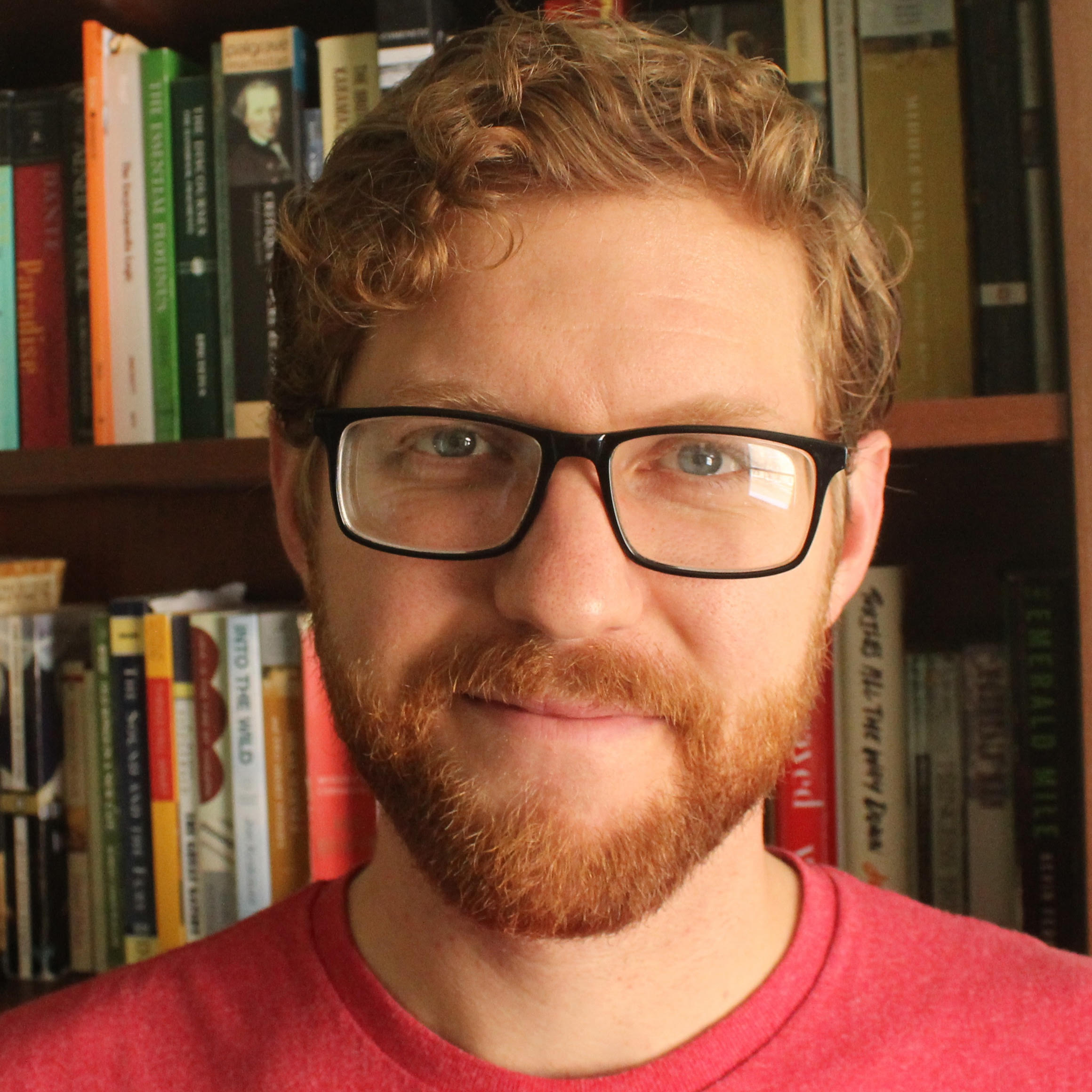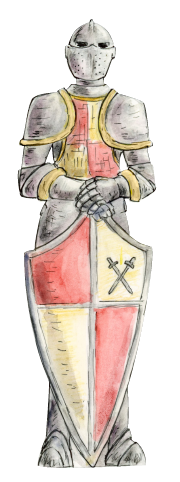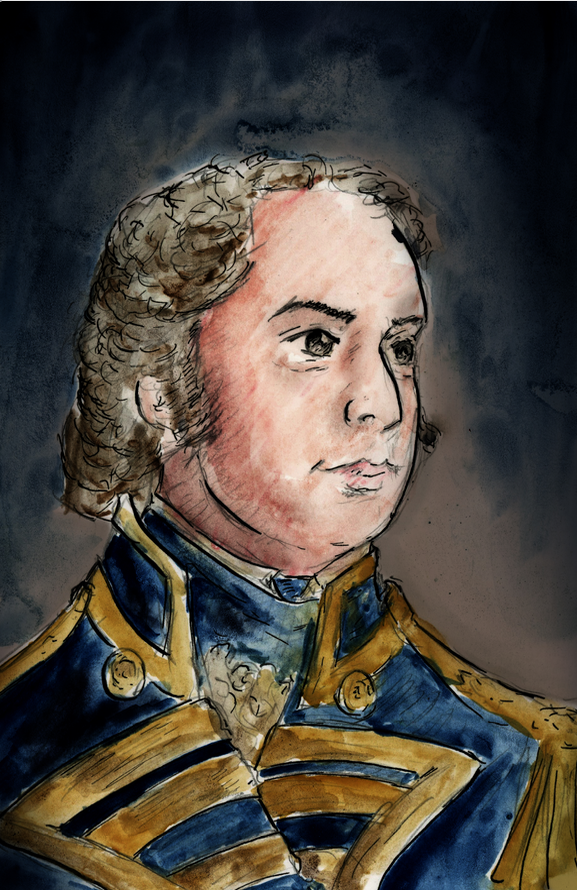Getting to Know: Gentleman's Guide Projection Designer Topher Blair
By Leslie Simon
Topher Blair uses projection design to enhance the worlds we see onstage, and we are excited to see where Blair takes us in our upcoming, Tony Award-winning musical "A Gentleman’s Guide to Love & Murder." In this elegantly beautiful and grotesquely silly show, projection designs are used to transport audiences from the English countryside to an ice skating rink to a weightlifting gym, and they also add surprising bits of humor to certain scenes. Read on as Blair discusses his inspirations and process, and what he hopes to see in the future of projection design.
Arvada Center: How did you find yourself creating projections in your career?
Topher Blair: In college I was a film major, and I got really into animations during that time. After college, I was looking to move to Denver, and I saw an ad stating that the Denver Center had a projection design internship - that's how I got in touch with Charlie Miller at the DCPA. I worked with him for a really long time, and it was so great to collaborate with him. Then in 2018, I went to NYU graduate school for their interactive communications program, with the thought that maybe I could do theatre and also branch out to other things with these skills.
AC: When you're beginning to work on a new production, how do you figure out what projections you will have to create?
TB: It always comes down to a conversation with the director. Projections are unique as a field, because the first conversation is rarely ever “What kind of projections are we going to have?” It's usually “does this show want projections in it?” There are a lot of shows that shouldn't have projections in them, so collaborative conversations might say “if we have projections added to the show, how are projections going to be part of this world that we are building?” Then as we're figuring out what projections could do to enhance this world, that’s where we start thinking of what these projections should actually look like.
AC: In what ways do you think projections would maybe take away from a show? When do you think you shouldn't use a projection?
TB: Sometimes there's this temptation to say “We don't need to build sets, because we will just have projections” - right? I have had those jobs and I have been happy to have them. But I think the projections work best when they are working in tandem, when the projection designer and scenic designer are in communication through the entire process, and they are both really trying to complement each other. That's what works out best. When projections are added on and the scenic designer didn't really think about them, that's when projections are usually not helpful and can actually be a hindrance.
AC: It sounds like collaboration is very important for you!
TB: Definitely. One of the things about this is that some of the projection designs that I'm doing are being incorporated into props and scenery, so basically I've got the style and look that I'm working on, and we're being really deliberate in bringing that into the real world as well. So there's a suit of armor that will exist on stage, as if it is this painted thing on stage, like a cardboard flat, and that's illustrated in the same style that's going on in the projections.
AC: We can’t wait to see how that looks. So after discussing the production with designers, how do you go about actually creating the projections?
TB: Different projection designers go about things in different ways. I usually start with pencil sketches for the entire show. I might do a few mock-ups to communicate what the general vibe is, but when I'm actually working on the show - have you ever taken a drawing class or anything like that?
AC: Yes, just an intro class.
TB: So you usually don't want to start with the feet and then do ankles and then do knees and then go all the way up…. you want to start broad, get a large sketch of the whole thing, and then work in the details. Usually I will start with loose pencil sketches for the entire thing, and then get a rough idea of what things will look like, then I’ll go in with fine pencils and ink, and then I'll color the entire thing. You may have noticed, I don't really have a lot of complete looks to share with you right now, because I'm in the coloring phase, and rather than do this look and then this look, I try my best to do this entire phase and then this phase in the whole process, until I start to have a vision of the play as a whole.
What’s not always common for projection designers is how much of my work happens on paper. At this point, a lot of folks use computer programs, doing their graphics on their computer. But for me, with decades worth of experience as a professional artist, what works best is drawing on paper. It really is the best way to actually make cool things. I've been fortunate at this point that there are folks who just kind of know what I usually like to do and make, and they say “oh this might be a show where we go for Topher's whole approach to projection design.”
AC: What a great place to be. I know that in theatre, things like the price of lumber for sets has gone up so much, and you mentioned how you don't necessarily want to just use projections instead of a set. Because of those costs and trying to make things sustainable, it seems like there could be an ever-growing future for this. How do you hope to see projection technology expand?
TB: I mean, I hope I get work contracts! But I think that's another part of the weird thing about projection design.
The thing you want to think most about with projections is how to make it cool, but also show restraint, and that restraint means that you want to ensure that the projections are serving the live experience. You want to make sure they are able to enhance what people are coming here to see, and can be part of that story in a way that preserves what is unique about theatre. I think it's really good that more and more theatres have projections as part of their tool kit, and I want to see people doing projections in a way that feels clever and integral to the story, instead of maybe thinking of projections as a way to solve practical problems, right?
AC: Absolutely.
TB: Like your comment about the cost of lumber. Well that might wind up working in my favor, but if you are hiring me you may be investing money in projection technology - and it’s not cheap! I hope in the future that more directors are able to consider projections as a part of a cohesive whole for their design.
AC: If you could design the projections for any production, what would be your dream projection job?
TB: "The Tempest" is a show that I would love to do at some point!
AC: What kind of ideas do you have for it?
TB: That show is all about dreams and reality, where those two worlds touch and where they separate. Like this magician, who is able to bring this dreamworld into the real world and we are able to see magic for a short period of time, in a way that's real magic, and then we go back to the real world where most of our characters live out their lives. I think that would be such an interesting show to do projections for, because the projections aren't concrete.
AC: Was there a moment working on "A Gentleman's Guide to Love & Murder" that was the most challenging, or most rewarding to work through so far?
TB: In terms of rewarding, so far the collaborative process has been really great! We've talked about bringing things into the world of projection, rather than bringing the world of the projections into the space. Those conversations have all been so much fun and so interesting because everybody's been really receptive to everything. In terms of the most challenging part…. I am sure that is yet to come. You know getting all of this stuff to work with actors on stage is going to be a challenge.
AC: When is your work done? Do you see a lot of changes during tech rehearsals?
TB: Hopefully my work is done on opening day! I mean, it's a great feeling when a show feels really solid after your first run-through in tech. But there's always more work to be done, and if you are lucky enough to feel like you have a solid show pretty early on, then there are just more things to explore and more ways to be creative - so there's always more work that can be done up until the show opens.
AC: Is there anything else you hope the audience gets out of seeing this particular version of "A Gentleman's Guide to Love & Murder?"
TB: I hope that people see this show, and if they have been lucky enough to see the original show, that they appreciate the new things that we're doing with it, while maintaining the overall tone of the original through the whole piece. We're not changing this musical’s meaning, we're just doing it in a different, fun way.




 What’s not always common for projection designers is how much of my work happens on paper. At this point, a lot of folks use computer programs, doing their graphics on their computer. But for me, with decades worth of experience as a professional artist, what works best is drawing on paper. It really is the best way to actually make cool things. I've been fortunate at this point that there are folks who just kind of know what I usually like to do and make, and they say “oh this might be a show where we go for Topher's whole approach to projection design.”
What’s not always common for projection designers is how much of my work happens on paper. At this point, a lot of folks use computer programs, doing their graphics on their computer. But for me, with decades worth of experience as a professional artist, what works best is drawing on paper. It really is the best way to actually make cool things. I've been fortunate at this point that there are folks who just kind of know what I usually like to do and make, and they say “oh this might be a show where we go for Topher's whole approach to projection design.”